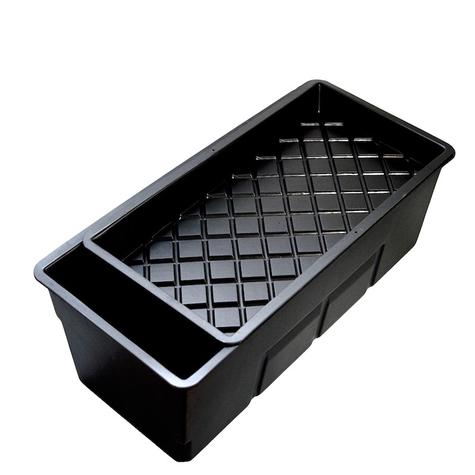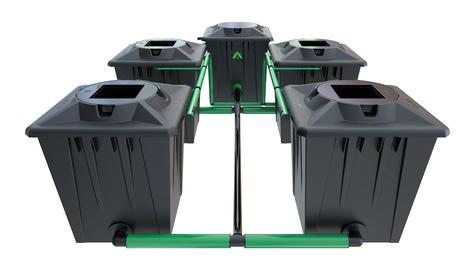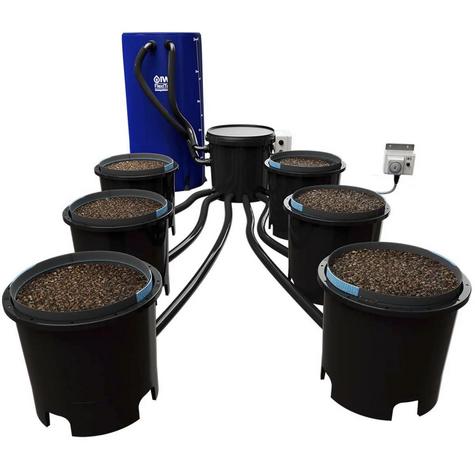
Hydroponics serves as an innovative method of cultivation, enabling farmers to grow plants without soil by using nutrient-rich water solutions. This approach, termed hydroponic farming, has gained popularity due to its efficiency and the ability to produce high crop yields in reduced spaces. Hydroponic systems, which can range from passive hydroponic setups to more complex aeroponics, allow for precise control over nutrient delivery and environmental factors. In a hydroponic garden or farm, plants thrive by receiving nutrients directly through their roots, leading to faster growth and potential year-round production. Exploring hydroponics - an introduction to indoor growing not only illustrates the versatility of these systems but also highlights the advancements in sustainable agriculture practices.
Hydroponics refers to a method of growing plants without soil, using nutrient-rich water solutions instead. This innovative approach, known as hydroculture, has gained popularity in urban and indoor farming. By optimising the surface area of plant roots and providing essential nutrients directly, hydroponics allows efficient watering techniques. Systems may vary, with options like deep water culture and aeroponic setups, enabling effective oxygenation and nutrient absorption through water pumps.
The historical roots of hydroponics can be traced back to ancient civilisations that recognised the benefits of cultivating plants using water-based methods. Over the years, this technique has evolved significantly, leading to modern applications in controlled environments. Today, hydro plants thrive in diverse settings, utilising tap water and ground water sources to deliver nourishment. Proper management of air vents and water is crucial for success in this indoor gardening revolution, a concept encapsulated in the phrase Hydroponics.
Hydroponics - An introduction to Indoor Growing offers significant advantages over traditional farming methods. The absence of soil as a growing medium simplifies the cultivation process, allowing for a more controlled environment. This setup utilises a water reservoir to provide nutrients directly to the plants, which helps mitigate issues associated with hard water when using traditional methods. The ability to maintain clean water qualities not only reduces water stress on plants but also promotes healthier growth. Furthermore, with techniques like deep water culture, plants receive ample oxygen through an air pump, enhancing their development.
Water conservation remains a crucial benefit of hydroponic systems, as they use up to 90% less water compared to conventional agriculture. With grow lights and a well-designed ventilation system, growers can optimise their indoor environments, ensuring plants receive the right light intensity and temperature conditions. This efficiency leads to faster growth cycles and higher yields per square metre, making hydroponics a sustainable choice for urban gardening enthusiasts. Emphasising soft water qualities also contributes to better nutrient absorption, further bolstering the health and productivity of the plants involved in Hydroponics.
Hydroponics - An introduction to Indoor Growing opens up new avenues for cultivating gardens devoid of traditional soil. This innovative approach utilises systems like the nutrient film technique, effectively delivering nutrients and moisture directly to plant roots. By creating controlled environments, growers can optimise factors such as room temperature and ventilation, ensuring plants thrive year-round. Reservoirs and tanks filled with bottled water provide the necessary hydration, while artificial lights simulate sunlight, promoting robust growth. The adoption of hydroponics significantly enhances the efficiency of food production, making it a sustainable alternative amid increasing urbanisation and the challenges posed by sewage plants.

Indoor hydroponic farming offers a revolutionary approach to cultivating plants without soil. By utilising a soilless medium, such as rock wool or coconut coir, growers can efficiently manage nutrient delivery directly to the roots. This method allows for precise control over plant growth, with options for vertical farming to maximise limited space. A bucket system can be integrated within this setup, allowing for easy nutrient monitoring through a connected reservoir. Hydroponics encourages sustainable practices and makes gardening accessible in urban environments.
Artificial lighting plays a critical role in indoor garden hydro projects, providing the necessary spectrum for photosynthesis. The right hydroponics system can ensure plants receive consistent light exposure, promoting optimal growth conditions regardless of external weather conditions. Indoor hydroponic farming enables hydroponics growers to cultivate a diverse range of crops year-round, significantly increasing yield potential. By maintaining controlled environments, enthusiasts can create thriving indoor gardens that are both productive and environmentally friendly.
A hydroponic system is composed of several key components that work together to create an efficient growing environment. One of the crucial elements is the hydroponic medium, which supports plant roots while retaining moisture and nutrients. Hydroponics offers approaches that cater to both beginners and experts, allowing them to adapt the system to their specific needs. For those focusing on vertical hydroponic technology, selecting the right hydroponic grow configuration is essential for optimising space and yield. Hydroponics outdoors can also benefit from understanding these components for effective cultivation in varied settings.
Each component serves a unique purpose in facilitating plant growth without soil. An active hydroponic system relies on nutrient solutions delivered directly to the plants, ensuring they receive the necessary elements for healthy development. Hydroponics experts often emphasise the importance of a well-chosen hydroponic system, as this can significantly impact growth rates. Hydroponics highlights how a systematic understanding of these components can empower both novices and seasoned gardeners to refine their practices, enhancing overall productivity and sustainability.
Hydroponics encompasses a variety of systems that cater to the needs of indoor gardeners. Each method offers unique advantages, such as the lightweight hydroponic systems that save space while providing an efficient way to grow hydroponic plants. Among these, the simple hydroponic system can be ideal for beginners seeking to enhance their hydroponic gardening experience. Techniques like nutrient film technique (NFT) and deep water culture (DWC) exemplify innovative hydroponic methods that utilise precise nutrient delivery for optimal growth. For those venturing into proper indoor grow setups, understanding the requirements of each system is crucial. Whether using a pumped hydroponics system or exploring ebb and flow systems, the goal remains the same: to maximise the potential of hydroponics nutrient solutions for thriving indoor growing.

The Nutrient Film Technique is a popular passive hydroponic system favoured by many hydroponic gardeners. It involves a thin film of nutrient-rich water that continuously flows over the roots of plants, allowing them to absorb specific hydroponics nutrients efficiently. This method is particularly effective for indoor grows, making it a go-to choice for those engaged in hydro plant growing. As part of Hydroponics - An introduction to Indoor Growing, this technique helps enhance nutrient uptake while minimising water usage, aligning with eco-friendly gardening practices.
This hydro system is suitable for various types of plants and can be implemented easily by novice gardeners or seasoned indoor growers. With proper knowledge from an indoor grow guide, even those new to indoor gardening can successfully set up their own indoor grow using this technique. Understanding the principles of Nutrient Film Technique can dramatically improve the yield and quality of crops, making it an invaluable method for efficient hydro grow operations.

This hydroponic system has gained substantial popularity among novice indoor gardeners due to its simplicity and effectiveness. It allows for the cultivation of a variety of crops. The design typically consists of a reservoir filled with nutrient-rich water, which directly supplies the plants' roots. This direct contact with the nutrient solution ensures robust growth and can lead to higher yields compared to traditional soil methods. Hydroponics has attracted many to experiment with their grow rooms, making it easier to achieve optimal results.
The hydro system is characterised by its reliance on a constant flow of oxygenated nutrient solution, making it a prime choice for those interested in maximising their hydroponics experience. Hydroponics fertilisers play a crucial role in this method, providing essential nutrients tailored to the specific needs of the plants being grown. The system mimics the principles of aeroponic systems, where roots are suspended in the air and misted with nutrient solutions. By utilising mirrors hydroponics, growers can enhance light distribution within their indoor gardens, further promoting healthy plant growth and ensuring that every stage of development is adequately supported.

Ebb and Flow systems exemplify an innovative approach to Hydroponics - An Introduction to Indoor Growing. These systems utilise a cycle of flooding and draining to provide plants with a consistent supply of water and nutrients. During the flooding phase, the hydro-feed, a nutrient-water solution, fills the grow bed, allowing the roots of the plants to absorb the water-nutrient solution effectively. The water level is carefully managed to ensure that the roots are adequately submerged while preventing over-saturation. This method creates a transformative indoor environment where plants can thrive.
After the flooding phase, the system drains, causing the used water to return to a reservoir. This cycle not only ensures that plants receive correct watering but also promotes aeration and healthy root development. Maintaining optimal grow room temperature is crucial, as it affects both the nutrient uptake and the rates of evaporation. Ebb and Flow systems stand out among various water culture systems for their efficiency in providing plants with essential nutrients while conserving water, making them an excellent choice for indoor gardening enthusiasts.
Setting up a home hydroponic system offers a fantastic opportunity to cultivate plants in a controlled environment indoors. Understanding the basics of Hydroponics is essential for success. A DWC hydro system is especially popular for beginners, featuring a self-contained water system that allows plants to thrive in a nutrient-rich water solution. Using a mesh pot ensures optimal aeration for roots, while a humidity dome can enhance moisture retention properties, creating a favourable microclimate for growth. Ensuring a reliable water source and maintaining the nutrient solution reservoir are pivotal for promoting healthy plants. By optimising these elements, one can effectively harness the advantages of water culture, paving the way for a rewarding indoor gardening experience.
Selecting the most suitable hydroponic system for your home is essential for successful year-round gardening indoors. Beginners may prefer simpler setups, such as drip systems or deep water culture, which require minimal maintenance and offer ample room for growth.
Understanding the specifications of your chosen hydroponic system will aid in optimising plant growth. For instance, consider the mesh pot diameter to accommodate the roots, and the type of organic plugs or organic grow medium needed for starting seeds. A water-efficient method such as a drip system can create a sustainable environment, reducing water usage while promoting healthy plants. Hydroponics encourages creativity in designing a system that fits your available space and gardening ambitions.
A well-equipped hydroponic system is essential for successful indoor gardening. Organic growers often choose home gardening systems that incorporate small pipes for nutrient delivery and effective drain techniques to manage excess water. Implementing a suitable ventilation system enhances air circulation, creating an ideal environment for plant growth. The use of LED lights or HPS {High Pressure Sodium} bulbs ensures that plants receive adequate light.
Containers can vary widely in size and style, allowing for flexibility in container gardening. Employing poly-tunnels in conjunction with indoor systems can improve temperature control and humidity regulation. Vents play a crucial role in maintaining airflow, ensuring that plants receive fresh air while minimizing the risk of fungal diseases. Understanding these essential supplies and equipment can make Hydroponics a rewarding experience for enthusiastic gardeners.
Setting up your own hydroponics system can be an exciting venture, especially as Hydroponics offers numerous possibilities. Identify an available area in your home, be it an empty garage or a cozy corner indoors. The bucket technique is a popular choice for beginners and can easily be adapted for various spaces. Ensure that you have the necessary components, such as a fish tank oxygenator for efficient aeration, and consider using commercial greenhouse technology to optimise system performance.
Proper ventilation is crucial to maintaining a healthy growing environment. Grow lights generate artificial sunlight, making them essential for indoor setups where natural light may be insufficient. Selecting the right type of light and ensuring adequate airflow will enhance plant growth while allowing for water saving practices that differentiate hydroponics from traditional gardening methods. Embracing Hydroponics can lead you towards fruitful and sustainable gardening within your own home.
Hydroponic Indoor Growing relies heavily on optimising conditions for plant growth within controlled environments. Techniques can vary widely, from using simple setups such as a 5-gallon bucket system to more complex equipment designed for larger spaces like a garage. Proper ventilation plays a crucial role, ensuring plants receive adequate air circulation and preventing stagnant conditions. While some may consider replicating an outdoor spring garden, indoor systems can be tailored to suit specific needs, allowing for a more consistent yield free from the challenges of external weather. Regular monitoring of nutrient solutions and pH levels contributes significantly to the thriving ecosystem of a hydroponic garden.
Understanding the light requirements is crucial for successful hydroponics, especially for indoor environments where natural sunlight may be limited. Growers often turn to artificial lighting to ensure their water-loving plants receive adequate illumination. Selecting a nutrient pump handy for maintaining a consistent flow of nutrient solution can enhance plant growth. The choice of grow medium also plays a significant role, as it needs to support the roots effectively while allowing for even distribution of light.
Efficient light management optimises growth by replicating the ideal conditions found in nature. Growers should consider using equipment suited for the specific needs of different species, such as high-intensity discharge (HID) lights or LED systems. Placing plants in a large pot on level ground can provide stability and promote better light exposure. Understanding these elements in Hydroponic Growing sets the foundation for developing a thriving indoor garden.
Proper formulation of nutrient solutions is crucial for successful hydroponics. Growers must consider the specific needs of their plants and the particular system being used. For those utilising pots or a 5-gallon bucket in a flex farm setup, the solution should be tailored to ensure optimal growth within a controlled environment. It is essential for the nutrient mix to reach the roots effectively, especially if using a mesh system that allows for air to circulate freely around the pot.
Maintaining appropriate pH levels is another vital aspect of hydroponics. Each plant species thrives within a specific pH range, which in turn affects nutrient uptake. Regular monitoring is necessary to adjust the pH in the nutrient solution, especially in a room where different variables can influence the overall environment. For hydroponics , ensuring a balanced pH will maximise growth and yield, allowing plants to flourish in their designated area.
Hydroponics - An introduction to Indoor Growing opens up a world of possibilities for cultivating plants in a controlled environment. Plants thrive in this innovative medium, utilising a nutrient solution tailored to their needs. Proper management of nutrient levels and the use of appropriate lights are essential for optimal growth. By embracing hydroponics, enthusiasts can easily create a ready-to-harvest garden that flourishes indoors, showcasing the remarkable potential of soil-less agriculture.